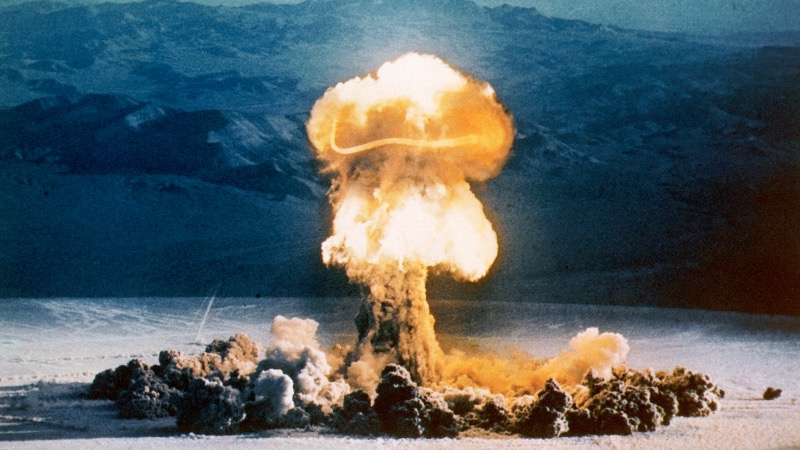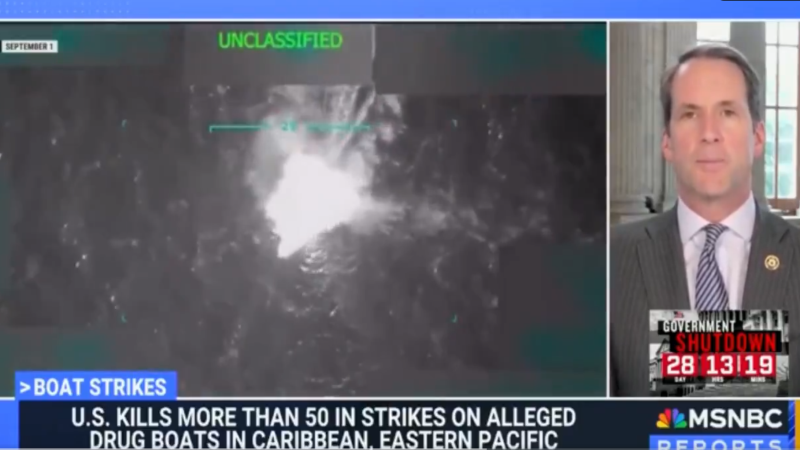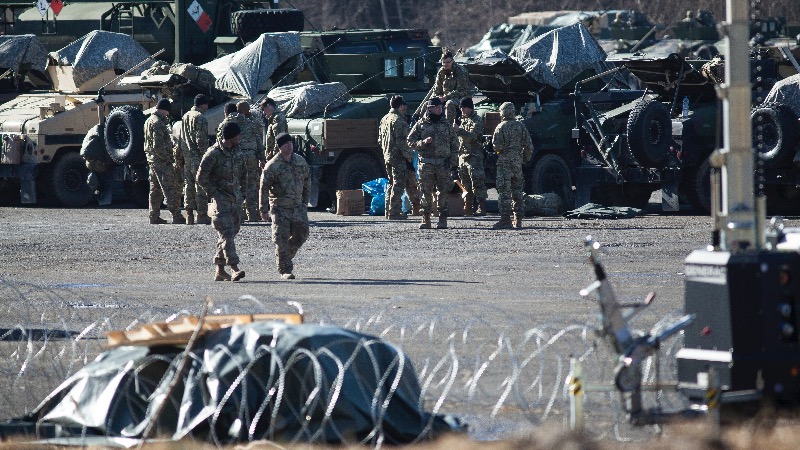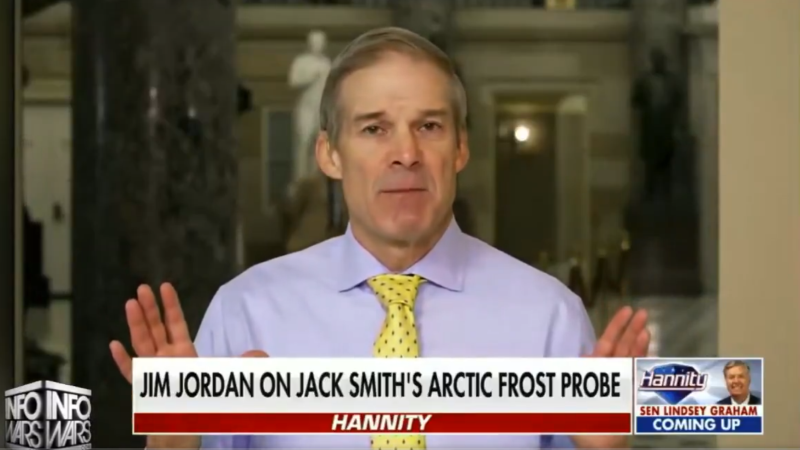 Image Credit: Historical / Contributor / Getty
Image Credit: Historical / Contributor / Getty On Wednesday evening President Donald Trump announced the United States will resume nuclear weapons testing. Currently the U.S. is banned from conducting all but underground nuclear weapons testing under the 1963 Limited Nuclear Test Ban Treaty. A 1996 Comprehensive Nuclear Test Ban Treaty would also ban underground testing, although it is not entered into force. China has recently become belligerent on the topic of denuclearization, Trump’s statement comes just hours before he is set to meet with the country’s leader Xi Jinping.
The United States has more Nuclear Weapons than any other country. This was accomplished, including a complete update and renovation of existing weapons, during my First Term in office. Because of the tremendous destructive power, I HATED to do it, but had no choice! Russia is second, and China is a distant third, but will be even within 5 years. Because of other countries testing programs, I have instructed the Department of War to start testing our Nuclear Weapons on an equal basis. That process will begin immediately. Thank you for your attention to this matter! PRESIDENT DONALD J. TRUMP

Castle Romeo was the code name given to one of the tests in the Operation Castle series of American thermonuclear tests beginning in March 1954 at Bikini Atoll. 1954. It followed Operation Upshot-Knothole. The ultimate objective was to test designs for an aircraft deliverable thermonuclear weapon. Marshall Islands, Pacific. (PHoto by Galerie Bilderwelt/Getty Images)
Of note is the President’s words of “tremendous destructive power” indicating that he is likely aware of the horrors the Japanese experienced following their atomic experiences in 1945.
Embed from Getty ImagesGovernment filmmakers document an atomic bomb explosion at the test site in Nevada. 1957. A Jeep has been equipped with a movie camera and is not far from the nuclear blast. Nye County, Nevada, USA. (PHoto by Galerie Bilderwelt/Getty Images)
Democrat President Harry Truman began to laugh (at 2:30 into the video) as he announced the destructive power he unleashed on civilians, although when he noticed the camera was rolling he appeared shocked as he regained composure.
Trump has repeatedly championed an agenda of global denuclearization numerous times, including after he assumed office for his second term.
Trump’s past statements indicate he is likely aware of the true scale of modern nuclear weapons.
The President’s nuclear test statement comes one year after the violent autumn of 2024, characterized by near-world-ending conventional missile exchanges and nuclear proliferation from both sides.
Given that Trump is set to meet China’s leader Xi Jinping on Thursday, his hawkish statement on nuclear testing is likely nothing more than geopolitical brinksmanship, either that or the 79-year-old man has “learned to stop worrying and love the bomb.”
Embed from Getty ImagesSoldiers and cameramen near the Small Boy nuclear test, part of Operation Sunbeam also known as Operation Dominic II. Nevada, 14th July 1962. (PHoto by Galerie Bilderwelt/Getty Images)
China has become defiant and refused to comply with Trump’s global denuclearization agenda. CBS reported August 27:
Embed from Getty ImagesWhen asked about Mr. Trump’s comments, Beijing’s foreign ministry spokesman Guo Jiakun said Wednesday it was “neither reasonable nor realistic” to expect China to participate in trilateral nuclear disarmament negotiations with the United States and Russia.
“China and the United States are not at the same level at all in terms of nuclear capabilities,” Guo told reporters.
“The countries with the largest nuclear arsenal should earnestly fulfil their special and primary responsibility for nuclear disarmament,” he said.
Beijing says it favors disarmament in principle but has regularly rejected Washington’s invitations to join US-Russian talks on reducing their nuclear arsenals.
A mushroom cloud seen from Eneu Island, resulting from an atomic explosion of “Able” during Operation Crossroads, July 1, 1946. | View from: Eneu.
Despite increasing European tensions, Trump continues his pivot to Asia and chiefly to China, a topic Infowars recently reported on.
As to European developments, Infowars went into great detail and linked the documents on the technical workings of Russia’s new doomsday machine, a nuclear-powered ramjet missile, similar to the 1950’s American armageddon weapon. Western Europe continues their push for long-range missiles for Ukraine to strike deep into Russia with.
Regarding Trump’s nuclear testing announcement, one treaty stands in the way of all but below-ground testing:
Embed from Getty ImagesOn August 5, 1963, the Limited Test Ban Treaty was signed by the United States, Great Britain, and the Soviet Union. After Senate approval, the treaty that went into effect on October 10, 1963, banned nuclear weapons testing in the atmosphere, in outer space, and under water.
In August of 1945, when the United States dropped two atomic bombs on Japan, World War II came to a conclusion.
Continued testing of atomic and then hydrogen devices lead to a rising concern about the effects of radioactive fallout. As knowledge of the nature and effects of fallout increased, and as it became apparent that no region in the world was untouched by radioactive debris, the issue of continued nuclear tests drew widened and intensified public attention. Apprehension was expressed about the possibility of a cumulative contamination of the environment and of resultant genetic damage.
Efforts to negotiate an international agreement to end nuclear tests began in the Subcommittee of Five (the United States, the United Kingdom, Canada, France, and the Soviet Union) of the United Nations Disarmament Commission in May 1955. Public interest in the course of the negotiations was active and persistent. A dozen resolutions of the UN General Assembly addressed the issue, repeatedly urging conclusion of an agreement to ban tests under a system of international controls. Efforts to achieve a test ban agreement extended over eight years because they involved complex technical problems of verification and the difficulties of reconciling deep-seated differences in approach to arms control and security. The uneven progress of the negotiations was also a result of regular fluctuations in East-West political relationships during the Cold War.
The Test Ban Treaty was signed in Moscow on August 5, 1963; ratified by the United States Senate on September 24, 1963; and entered into force on October 10, 1963. The treaty prohibited nuclear weapons tests “or any other nuclear explosion” in the atmosphere, in outer space, and under water. While not banning tests underground, the treaty prohibited such explosions if they caused “radioactive debris to be present outside the territorial limits of the State under whose jurisdiction or control” the explosions were conducted. In accepting limitations on testing, the nuclear powers accepted as a common goal “an end to the contamination of man’s environment by radioactive substances.”
American General HP Storke and other military personnel, having emerged from their foxholes to observe the atomic bomb explosion at the Nevada Proving Grounds, a nuclear testing site near Camp Desert Rock, Nevada, 15th May 1952. (Photo by United States Army/FPG/Archive Photos/Getty Images)
A comprehensive test ban treaty came into existence in 1996 but is not in force:
The Comprehensive Nuclear-Test-Ban Treaty (CTBT) bans all nuclear test explosions, whether for military or civilian purposes. The Treaty was opened for signature in 1996 to stop the development of new nuclear weapons and prevent upgrades to existing ones, supporting global efforts in non-proliferation and disarmament.
Another key document is the resolution adopted by the States Signatories on 19 November 1996, which established the Preparatory Commission for the Comprehensive Nuclear-Test-Ban Treaty Organisation (CTBTO).
Although the Treaty has not yet entered into force, it has made a significant contribution to international peace and security. It has helped to establish a strong global norm against nuclear testing and built confidence that any nuclear test explosion would be reliably detected.
BREAKING EXCLUSIVE: Nick Fuentes Endorses The Monroe Doctrine & Supports Regime Change In Venezuela


